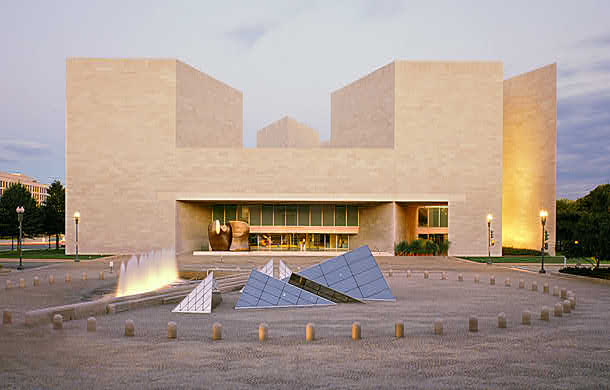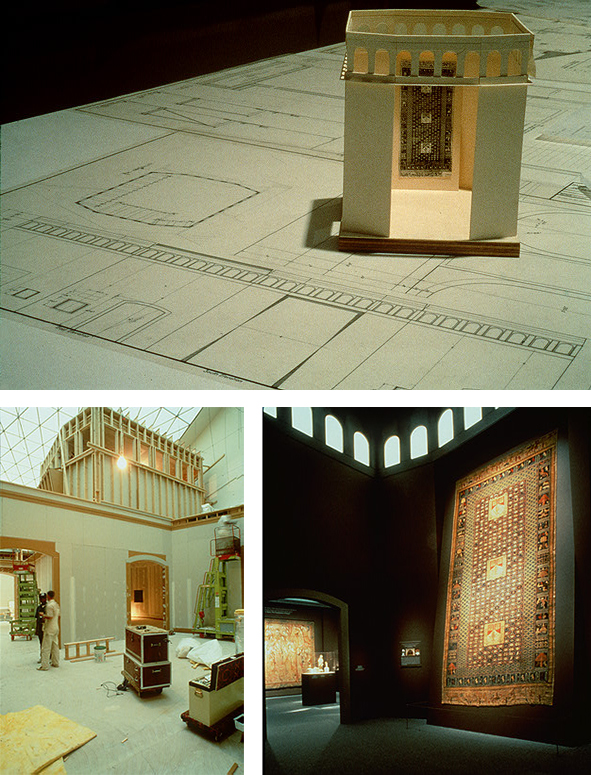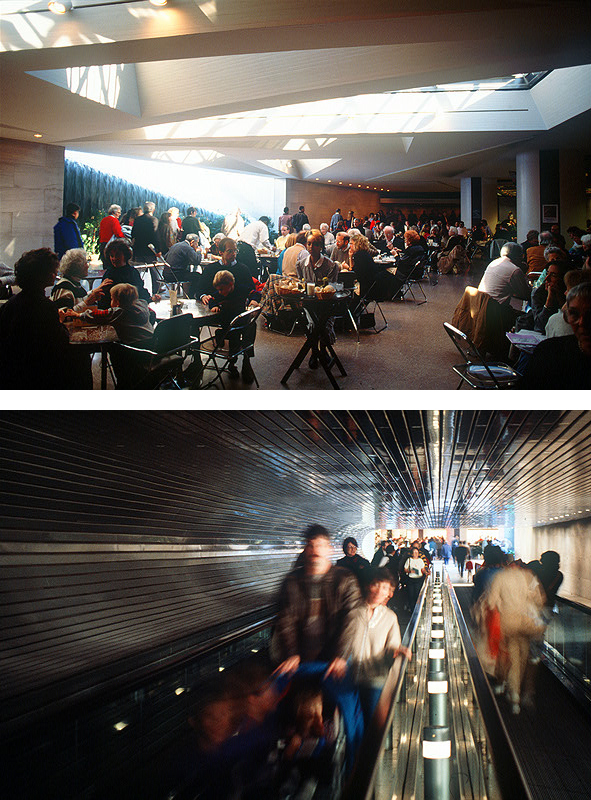East Building Architectural Tour

Exterior
Looking from the Mall toward the front of the East Building, massive towers with connecting bridges mark the exhibition spaces. At the entrance, Knife Edge Mirror Two Piece, a colossal abstract bronze by Henry Moore, announces the modern art within.
The dramatic geometry of architect I. M. Pei's great "H"-shaped façade matches the equally severe walls of the West Building, which is situated across the plaza seen in the photograph above. To correspond in texture and color to the original building, the new one is faced inside and out with lavender-pink marble from the same quarry in Tennessee.
The older West Building (opened 1941) is based on foursquare, right-angled forms, while the newer structure interlocks complex, shifting triangular shapes. To emphasize these sharp angles, lighter stone was chosen for all the East Building's vertical corners. The 19-degree fin at the west corner of the library and office area, seen at the right in the photograph above, rises 107 feet above ground to the roofline.
East Building, 4th Street façade, Photograph: © Dennis Brack/Black Star

Materials
The East building is faced with marble (left), while poured concrete (right) was used for parts of the structure such as the coffered ceilings and the bridges that span the atrium. Architect I. M. Pei took steps to ennoble these surfaces by mixing the cement with the dust of the Tennessee marble, giving the concrete a warmer hue.
(top) East Building, detail of marble facing, Photograph by Lyle Peterzell, Department of Imaging and Visual Services, National Gallery of Art
(bottom) East Building, detail of poured concrete, Photograph by Lyle Peterzell, Department of Imaging and Visual Services, National Gallery of Art

The concrete was poured into molds constructed of wooden slats, which left a distinct, deep impression. Each mold was used once and then discarded. Pictured above on the left are molds for the coffering of the concrete ceilings of the East Building. On the right is an example of this coffering in the ceiling of the East Building's Study Center.
Audio: I. M. Pei and Earl A. Powell III
Architectural Concrete
RealAudio
(left) Molds for poured concrete coffers, William Mann Collection, Gallery Archives, National Gallery of Art
(right) East Building, poured concrete coffers in the Study Center, Photograph by Lyle Peterzell, Department of Imaging and Visual Services, National Gallery of Art

Interior, Atrium
Bridges and mezzanines create a vertical orientation throughout the East Building. When visitors leave one exhibition, they return to the atrium before entering another one. The triangular layout of the floor plan generates a sense of exploration: one must choose to turn left or right, go up or down.
The atrium's indoor garden, which is larger than one-third of an acre, is roofed by a "space-frame" of glass pyramids. A screen of aluminum rods reduces the sunlight so that visitors' eyes adjust to the galleries, where dimmer light levels protect the works of art from fading. This space-frame roof also animates the interior by casting a changing pattern of shadows over the walls and the mobile Untitled, commissioned for this space from Alexander Calder.
East Building, atrium, Photograph: © Dennis Brack/Black Star

Interior, Exhibition Spaces
Flexibility is the keynote to the East Building, both for loan exhibitions and for changing selections from the Gallery's twentieth-century collection. The exhibition area consists of eleven large spaces. Visitors seldom see the full extent of these areas because the spaces are continually partitioned and reshaped to best display the works of art on view. Any wall in the East Building that is not clad in lavender-pink stone is temporary, similar to movie or stage sets. The images above illustrate how an idea for an exhibition space in the Circa 1492 exhibition became a structure housing works of art -- in this instance, Islamic rugs.
(top) Maquettes and drawings of exhibition spaces for Circa 1492, Photograph Kathleen Buckalew, Department of Design and Installation, National Gallery of Art
(bottom left) East Building, exhibition space for Circa 1492, under construction, Photograph Kathleen Buckalew, Department of Design and Installation, National Gallery of Art
(bottom right) East Building, exhibition space for Circa 1492, completed, Photograph Kathleen Buckalew, Department of Design and Installation, National Gallery of Art

Ceiling heights vary throughout the five stories of available exhibition space. On the Ground Level, 10-foot ceilings are ideal for the display of intimate works of art such as drawings, prints, and photographs. The Tower Galleries, 35 feet high and accessible by elevator and spiral staircases, allow the installation of large sculpture, such as these welded steel pieces by David Smith. Exhibition designers can manipulate the skylights to mix natural and artificial light and change ceiling heights. The two illustrations above depict the same space during different exhibitions -- David Smith, shown on the top, and Treasure Houses of Britain, on the bottom.
(top) East Building, exhibition space for David Smith, Photograph Department of Design and Installation, National Gallery of Art
(bottom) East Building, exhibition space for Treasure Houses of Britain, Photograph Bill Schaeffer, Department of Design and Installation, National Gallery of Art

Interior, Concourse and Foundations
Like the pilings that support the West Building, the East Building also rests on the underlying mud of the Mall, but it features a technology not available in 1937 when the West Building was constructed. The East Building has a reinforced concrete foundation 6 feet thick, poured in one continuous flow so that the basement is a water-tight unit that floats like a gigantic ship's hull.
Beneath the plaza, the two-story underground concourse connecting the old and new structures is engineered with waterproof friction joints. This eases any stresses while the four-block-long complex rises and sinks by millimeters each year.
(top) East Building, Concourse Café and waterfall, Photograph: © Dennis Brack/Black Star
(bottom) East Building, Concourse, moving walkway, Photograph: © Dennis Brack/Black Star

Interior, Staff Spaces
The public reaps the benefits from the other triangular section of the East Building, even though that area is restricted in access. There, the staff conducts business and research. Policies are established, exhibitions are planned, catalogues are published, and educational programs are conceived. Also, a visiting faculty of international scholars gathers in the Center for Advanced Study in the Visual Arts, CASVA.
One of the world's major libraries for the arts extends below the office area in book stacks three stories deep underground. Balconies with additional book shelves adorn the reading room. The soaring library is visible through six stories of windows on the south lawn.
The East Building opened on 1 June 1978, and soon after, the staff offices were moved there. By 1983, the former service areas in the West Building were renovated into new public display spaces for sculpture and graphic arts.
(left) East Building, office areas and study center, Photograph Lyle Peterzell, Department of Imaging and Visual Services, National Gallery of Art
(right) East Building, Study Center library, Photograph Lyle Peterzell, Department of Imaging and Visual Services, National Gallery of Art